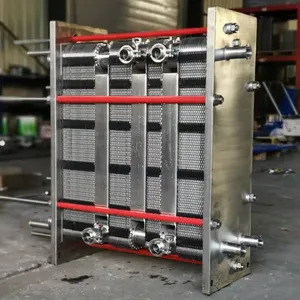Introduction
Ultra-compact heat exchangers (UCHEs) are cutting-edge thermal management solutions designed for applications where space constraints, weight reduction, and high thermal efficiency are critical. Unlike conventional heat exchangers, these advanced systems leverage microchannel structures, printed circuit technology, and advanced materials to maximize heat dissipation while minimizing volume. Industries such as aerospace, automotive, electronics cooling, and industrial processing require heat exchangers that provide high-performance thermal management without adding significant bulk or weight. UCHEs excel in such environments, offering superior heat transfer, enhanced durability, and the ability to operate under extreme conditions. Their adoption is rapidly increasing due to technological advancements in manufacturing processes like 3D printing, diffusion bonding, and microfabrication, which allow for the development of highly efficient and compact designs. As global industries focus on energy efficiency, sustainability, and high-performance engineering, ultra-compact heat exchangers have become an integral component of next-generation cooling and thermal regulation systems.
Key Features of Ultra-Compact Heat Exchangers
High Surface Area-to-Volume Ratio
- Designed with microchannels, fins, and advanced plate structures to increase surface area and improve thermal performance.
- Enhances heat transfer efficiency, making them ideal for applications with space limitations such as EV battery cooling, spacecraft, and miniaturized industrial systems.
Lightweight and Space-Saving
- Constructed using high-performance materials like aluminum, titanium, stainless steel, and copper alloys, reducing overall weight.
- Compact geometry allows integration into tight spaces without compromising cooling performance, particularly in electric vehicles, satellites, and compact electronics.
Superior Thermal Performance
- Features counterflow configurations, optimized fin structures, and turbulence-enhancing designs for efficient heat dissipation.
- Ensures stable thermal regulation even in high-power electronics, industrial reactors, and high-speed aircraft systems.
Advanced Manufacturing Techniques
- Utilizes modern fabrication methods such as 3D printing, laser cutting, and diffusion bonding to achieve precision-engineered heat exchangers.
- Enables customization of heat exchanger designs for specific performance needs, enhancing adaptability across multiple industries.
Durability and Reliability
- Built to withstand high pressures, extreme temperatures, and corrosive environments using materials like nickel alloys and stainless steel.
- Used in offshore oil rigs, space exploration systems, and high-performance cooling applications due to their rugged construction.
Multi-Fluid Compatibility
- Can handle a variety of heat exchange media, including liquids, gases, and phase-change materials (PCM).
- Essential for hybrid cooling systems, chemical process industries, and high-efficiency power generation applications.
Low Maintenance and Long Service Life
- Designed with self-cleaning mechanisms, corrosion-resistant coatings, and easy-to-maintain modular structures.
- Reduces operational costs and downtime in data centers, industrial processing plants, and HVAC systems.
Applications of Ultra-Compact Heat Exchangers
Aerospace & Aviation
- Used in aircraft engine cooling, satellite thermal regulation, and spacecraft heat management.
- Reduces weight and drag in aircraft, improving fuel efficiency and operational reliability.
Automotive & Electric Vehicles (EVs)
- Plays a crucial role in battery cooling, turbocharger intercooling, and powertrain temperature regulation.
- Enhances EV range and efficiency by maintaining optimal operating temperatures for lithium-ion batteries and fuel cells.
Electronics & Data Centers
- Integrated into liquid cooling solutions for processors, GPUs, and high-performance servers.
- Helps mitigate overheating risks in AI computing, supercomputing, and compact IoT devices.
Industrial Processing
- Used in steam condensers, chemical reactors, and high-efficiency heat recovery systems.
- Capable of handling aggressive fluids and extreme thermal loads in industries such as petrochemicals, pharmaceuticals, and power generation.
Renewable Energy & Power Generation
- Plays a vital role in solar thermal energy systems, geothermal power plants, and hydrogen fuel cell technology.
- Enhances energy efficiency by optimizing waste heat recovery and thermal regulation in clean energy applications.
Medical & Biotechnology Cooling
- Used in MRI machine cooling, pharmaceutical storage, and cryogenic preservation systems.
- Ensures precise thermal control for sensitive medical equipment and biological samples.
Conclusion
Ultra-compact heat exchangers are revolutionizing thermal management by delivering high efficiency, minimal footprint, and robust durability. Their ability to enhance heat transfer while saving space and weight makes them an indispensable solution across multiple industries. As industries continue pushing for higher performance, sustainability, and energy-efficient solutions, the demand for UCHEs will continue to grow. Future developments in nanotechnology, additive manufacturing, and hybrid heat exchanger designs will further enhance their capabilities, efficiency, and adaptability. Whether in next-generation electric vehicles, aerospace applications, or compact data center cooling, ultra-compact heat exchangers are shaping the future of thermal engineering.

